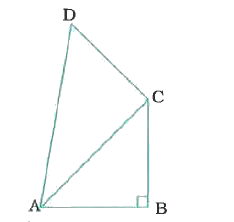In a quadrilateral ABCD, ∠B=90∘ and AD2=AB2+BC2+CD2. Prove that ∠ACD=90∘.
 Solution in Gujrati
Solution in Gujrati
The correct Answer is:∠ACD=90∘
Step by step video, text & image solution for In a quadrilateral ABCD, /_B= 90^(@)" and "AD^(2)= AB^(2)+BC^(2)+CD^(2). Prove that /_ACD= 90^(@). by Maths experts to help you in doubts & scoring excellent marks in Class 10 exams.
Updated on:21/07/2023Topper's Solved these Questions
- TRIANGLESBOOK - KUMAR PRAKASHANCHAPTER - TRIANGLESEXERCISE - EXERCISE 6.1
7 Videos
- TRIANGLESBOOK - KUMAR PRAKASHANCHAPTER - TRIANGLESEXERCISE - EXERCISE 6.2
12 Videos
- TRIANGLESBOOK - KUMAR PRAKASHANCHAPTER - TRIANGLESEXERCISE - OBJECTIVE QUESTIONS
37 Videos
- SURFACE AREAS AND VOLUMESBOOK - KUMAR PRAKASHANCHAPTER - SURFACE AREAS AND VOLUMESEXERCISE - TEST YOUR SKILLS
5 Videos
Similar Questions
Fill in the blanks using the correct word given in brackets :
All circles are………(congruent, similar)
View SolutionIn the given figures 1 and 2, DE∣∣BC. Find the EC in 1 and AD in 2.

View SolutionFill in the blanks so as to make each of the following statements true :
ΔABC~ΔDEF and 2AB=DE. If BC= 8 cm, then EF=………cm.
View SolutionThe slant height of a frustum of a cone is 4 m and the perimeter of circular ends are 18 m and 16 m. Find the cost of painting its curved surface at 10 per sq. m.
View SolutionIn a quadrilateral ABCD, ∠B=90o . If AD2=AB2+BC2+CD2 then prove that ∠ACD=90o .
View SolutionIn a quadrilateral ABCD, ∠B=90∘andAD2=AB2+BC2+CD2 prove that ∠ACD=90∘ .
View SolutionDetermine the point of symmetry of a regular hexagon.
View SolutionIn the figure above (not to scale), ¯¯¯¯¯¯AB⊥¯¯¯¯¯¯CDandAD is the bisector of ∠BAE.AB=3cm and AC=5cm. Find CD.
View SolutionMatch the following Column A to Column B

View SolutionMatch the following Column A to Column B

View SolutionMatch the following Column A to Column B

View SolutionThe inequation represented by the graph given below is :
View SolutionThe inequation that best describes the graph given below is _________
View SolutionThe inequation that best describes the following graph is _________
View SolutionIn the figure (not to scale) AB = AC and BD = CD. Find ∠ADB
ltimg src="https://d10lpgp6xz60nq.cloudfront.net/physics_images/PS_MATH_IX_C15_E05_003_Q01.png" width="80%"gt
View Solution
